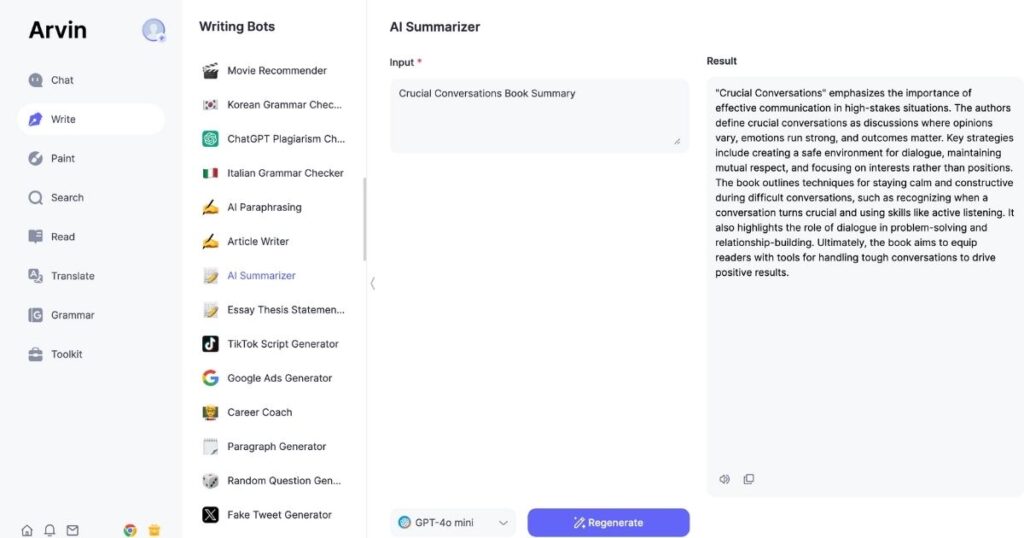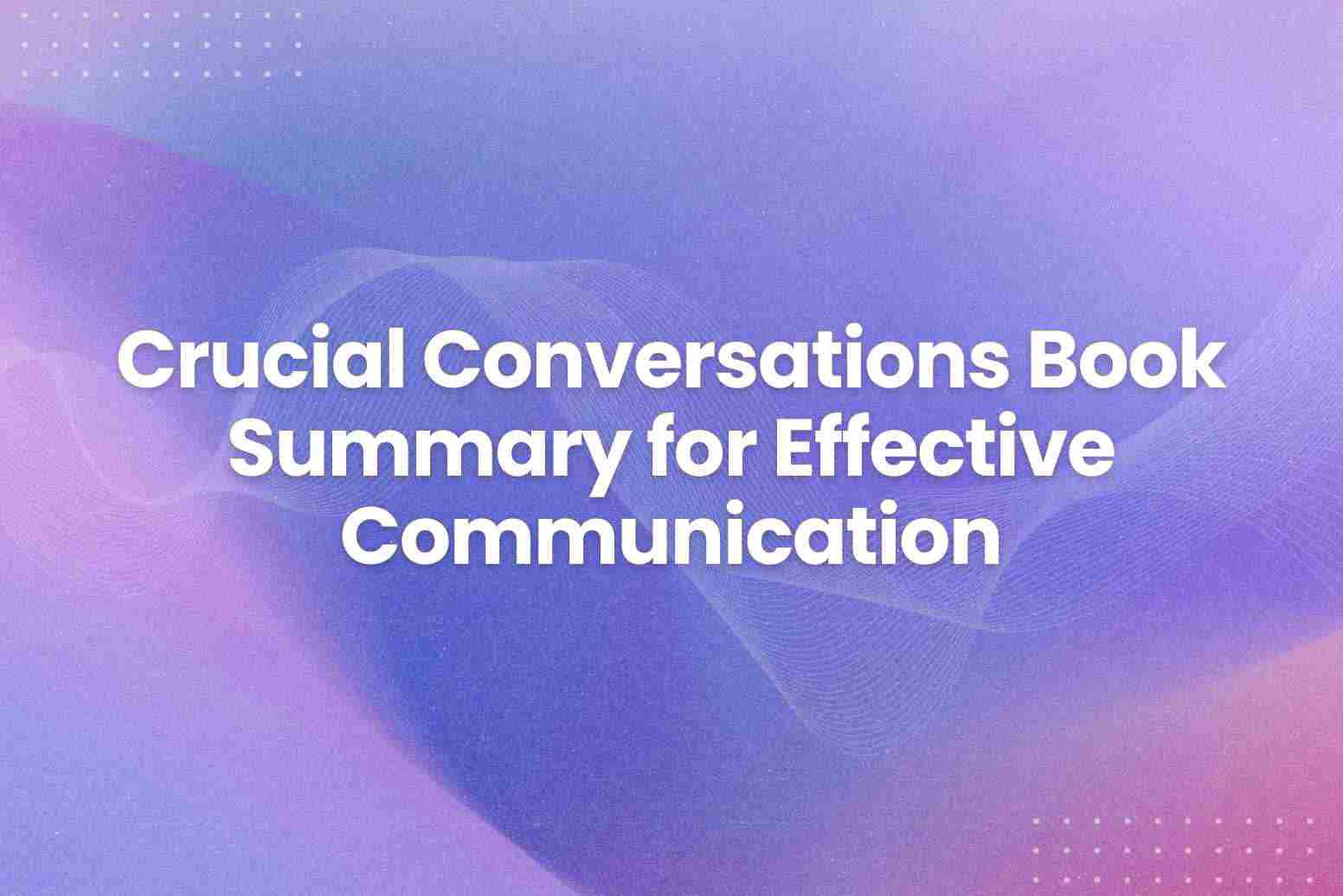Crucial conversations are situations when we have opposing opinions which are accompanied by strong emotions and the topic in discussion has high stakes. The unfortunate reality of crucial conversation is that when the stakes are the highest we tend to do our worst. This Crucial Conversations book summary will teach you how to avoid conflict and come to positive solutions in high-stakes conversations so you can be effective in your personal and professional life.

Crucial Conversations Book Summary
Crucial Conversations: Tools for Talking When Stakes Are High is a book that provides practical knowledge on how to engage in important conversations effectively.
The book outlines essential skills for engaging in conversations, such as staying calm, focusing on mutual purposes, and fostering a safe environment for dialogue. It introduces tools for effective dialogue, including how to identify when a conversation becomes crucial and how to handle difficult topics without escalating tension.
The authors stress the value of active listening and understanding others’ perspectives. Practical strategies for applying these skills in personal and professional settings are also provided, aiming to improve relationships and resolve conflicts constructively.
Overall, the book serves as a guide to navigate challenging conversations to achieve positive outcomes.
Here’s a summary of the most important ideas and messages the book promotes:
- Crucial conversations make sense only if all participants feel safe to voice their opinions.
- Always focus on the facts, not your interpretation of what the other person said
- The first step toward a successful conversation is looking at yourself and admitting others aren’t always to blame for a dialogue gone wrong
- Turning to sarcasm or giving the other person the silent treatment won’t result in a meaningful conversation
- Practice your listening skills—they’ll help you improve at crucial conversations
Are you worried about keeping up with your reading list or retaining important details from the books you’ve read? Unlock the power of Arvin to transform your reading experience with concise, insightful book summaries! Just like this Crucial Conversations book summary:

Just one click, and Arvin can quickly condense any book into highlighting key themes. Whether it’s a classic novel, a contemporary bestseller, or a scholarly work, Arvin’s algorithm processes the text to extract the essence.
Principles to Master Crucial Conversations
1. Start with Heart
Yes, it’s your heart. The first step to mastering the conversation is to gain self-knowledge. So the first rule is “practice with yourself first”. If you can’t get yourself right, you’ll have a hard time getting the conversation right.
One of the first steps to doing this is to understand that when faced with a failed dialogue, you are often quick to blame the other person. Although in rare cases you are the one who actually did absolutely nothing wrong; but often, people often contribute to the difficulties they go through.
The best people at the table not only understand this simple truth, but also realize that they are the only people they can change under any circumstances – the only people you can continue to stimulate. like and shape (with any degree of success) the person you see in the mirror.
Mature people always start from the heart
- They start high-risk discussions with the right motives and stay focused no matter what (they stick to their goals and believe that dialogue, in any whatever the circumstances, always make an option).
- They ask themselves, “What does my behavior tell me about my motives?”
- And ask yourself, “What do I want for myself? For others? For this relationship?”
- And, finally, “How would I behave if this is what I really want?”
- They say no to bad choices (an either/or choice) o For example testing to see if you can decide between win and lose or perfection and honesty.
- Create continuity with the conjunction “and”.
- Clarify what you don’t want, add it to what you really want, and ask yourself to start looking for sensible options for getting back into the conversation.
2. Learn to Look
Learning to look discusses the transition from an innocent to a crucial conversation and pinpoints the signs that indicate it. By recognizing these indications, you can pay attention to your words and actions and potentially prevent the conversation from going in the wrong direction.
Some tell-tale signs of a conversation becoming crucial include:
- Content and conditions (behavioral signals and emotions)
- Safety problems (silence and violence)
- Your own style and behavior in stressful situations
3. Make it Safe
There are four steps you can take to really listen to someone, summarized in the acronym AMPP: Ask, mirror, paraphrase, and prime.
- Ask (to get the ball rolling) Start by saying things like “I would love to hear your opinion about…”
- Mirror (to confirm feelings) This is saying things like “You look unsure…” Explain to them what you sense from the situation, in a calm and understanding tone.
- Paraphrase (to acknowledge their story) This will be “So if I understand you correctly…” Use this to understand how they feel.
- Prime (if you are getting nowhere) If someone clams up, we might need to encourage them to speak by suggesting what we think they might be feeling. “I guess you must think I’m being unfair…”
4. Master your Stories
The best discussion partners are not the hostages of their emotions but neither do they suppress their emotions. Instead, they act on their emotions.
If someone is hurting you with mean jokes, then hiding your dislike rarely works, because you will act on it involuntarily anyway. Instead, you should acknowledge your emotions and find a way to change it.
- You have to act differently first,
- To do that you need to feel differently,
- And to feel differently you need another story.
We tell ourselves clever stories that we believe are helping us process the events around us, but often they serve only as an excuse to do the easy things instead of the right ones.
The common point between the three-story types is that they are incomplete stories. We intentionally miss out on details to shape the story more in line with our narrative.
To solve this small lie of ours, we should expand our stories with the details we missed out on originally.
We should turn our clever stories into useful stories.
- Turn victims into actors: Find ways you could have contributed to the situation with your behavior, actions, or non-action. It is rarely the thing that you have no role in the problem at all.
- Turn villains into humans. Ask yourself the question about your supposed villain: “Why would a reasonable, rational, and decent person do what this person is doing?” Humanizing. the villain can lead closer to the truth.
- Turn the helpless into the able. If you find yourself in a helpless story ask yourself what do you really want and how can you get closer to that.
5. State your Path
When you make an environment safe for crucial conversations it does not mean that it will stay the same during the heated topics of the conversation. Discussing high-risk topics means we need to stay careful during the “Path to Action” line.
To stay on the safe side we should STATE our path, aka use the advice which makes the acronym:
- Share your facts: If you are missing money from your wallet and you suspect that your conversation partner stole it you usually start with some emotionally charged statement like: “You little liar, I trusted in you and you stole from me!” This immediately makes the conversation unsafe.
- Tell your story: Instead of starting with your story help others to see the situation from your point of you and and share your story as the possible best story you could come up with, but not as a sure story.
- Ask for others’ paths: After sharing the facts and showing our side of the story invite others to create alternative stories to get to know what you are missing and arrive at a truer story.
- Talk tentatively: When sharing a story be confident but show humility at the same time. Instead of expressions like “The fact is… Everyone knows…. The only way to do this…That’s a stupid idea.” use “In my opinion… I believe… I am certain…I don’t think it will work.”
- Encourage testing: When you invite others to contribute, make sure to emphasize the need for opposing viewpoints to avoid the Fool’s Choice. Sometimes you should play the devil’s advocate and model disagreeing with your own views.
6. Explore Others’ Path
After stating our path we should honestly invite others and we should do our best to truly understand their points of view. Most people when they hear opposing points of view, become furious, but to have a good conversation we should be curious about opposing views.
To encourage others to share their story we can use 4 power listening tools described in Crucial Conversations:
- Ask: When we show genuine curiosity and ask questions about others’ stories they become less defensive. They are less likely to stay silent or turn to violence if we ask honest questions. Asking also means we stop talking and let others fill the pool of meaning.
- Mirroring: Sometimes we should play the role of a mirror and share how we interpret others’ emotions and actions. This practice is even more useful when someone is sending contradictory signals (f.e: He says everything is good, but behaves differently).
- Paraphrase: When you are sure you know how the other is feeling you can build additional safety by repeating their story in your own words. You can start this with an introduction like “Let’s see if I get this right”.
- Priming: Priming in the context of an old-fashioned pump means that first, you have to pull some water into the pump to get it running. It works the same in conversation if your partners are reluctant to open up. Sometimes you have to guess what they are thinking, and how they are feeling and have to put those on the table for them to open up.
7. Move to Action
There are four common ways of making decisions: command, consult, vote, and consensus.
Regardless of which method you choose, it is worth forming clear commitments about the result of the conversation. To make it clear what is expected from whom, use the WWWF acronym:
- Who?
- Does what?
- By when?
- How will you follow up?
Final Words
To summarize, Crucial Conversations offers critical insights into effective communication, particularly in high-stakes situations where emotions are strong and opinions differ. The authors give readers real tools and strategies for encouraging open discourse, mutual respect, and providing a secure setting for honest conversations.
Finally, practicing the skills outlined in this book is about more than just speaking effectively; it is also about building relationships and developing an open and courteous society. Allow Arvin to walk you through the principles in Crucial Conversations and other amazing books! With a simple click, you may receive concise explanations of key concepts and practical applications. Don’t let important lessons slip away!
FAQs
The authors emphasize the importance of addressing opposing opinions accompanied by strong emotions in order to improve relationships and organizational performance. The book suggests that the ability to hold relevant crucial conversations can predict the success or failure of a project.
A crucial conversation is one in which: 1) the stakes are high; 2) opinions vary; and 3) emotions run strong. These types of conversations can happen at home and in the workplace. Being adept at handling this type of conversation can have benefits for your relationships, health, and career.
Through Crucial Conversations, you learn to see issues through the lens of our collaborators, make it safe to have dialogue on important issues, work more effectively as a committed team member, and problem-solve in ways that reduce barriers.
The book focuses on human relationships, exploring how people build and foster bonds through communication. The authors point out that knowing how to talk to people and handle tough conversations is the key to achieving success and maintaining personal health.
1: Start with Heart.
2: Learn to Look.
3: Make it Safe.
4: Master your Stories.
5: State your Path.
6: Explore Others’ Path.
7: Move to Action.






